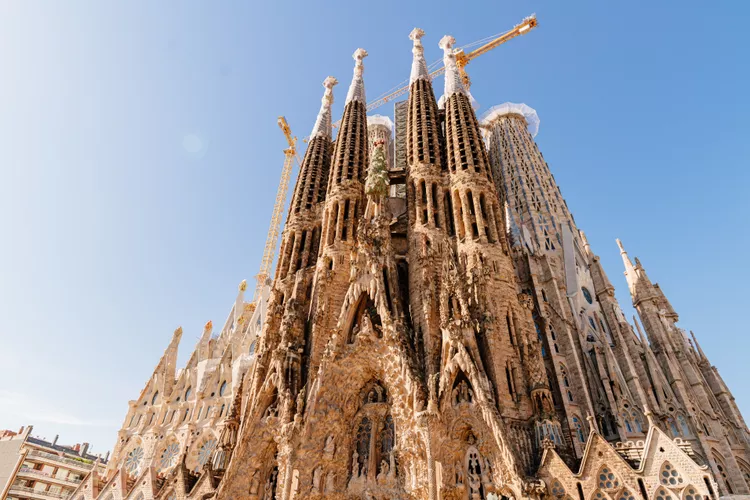Summary
More than a century after it was first commissioned, Barcelona’s most iconic landmark remains unfinished.
The Sagrada Familia church is Catalan architect Antoni Gaudí’s greatest masterpiece, but he never lived to see his most legendary creation come fully to life. In fact, none of us have (yet). The church is still under construction, with completion scheduled for 2026—a century after Gaudí’s death.
Despite technically still being a construction site, the Sagrada Familia remains Barcelona’s most popular tourist attraction, drawing more than 3 million visitors each year. While the jaw-dropping interior of the church certainly speaks for itself, knowing a bit of background information can enhance your visit significantly.
History
The story of the Sagrada Familia begins in 1874, when a local religious organization began advocating for the construction of a church honoring the Holy Family. Plans were drawn up, and the cornerstone of the church was laid on March 19, 1882, under the supervision of the project’s original architect, Francisco de Paula del Villar y Lozano.
Gaudí had no involvement in the earliest stages of the Sagrada Familia. After Lozano left the project due to creative differences, Gaudí was brought on to replace him. He discarded Lozano’s initial neo-Gothic design in favor of a modernist approach that would forever change the Barcelona skyline.
Starting in 1914, Gaudí dedicated himself entirely to the Sagrada Familia. He became so engrossed in the project that he practically lived in his workshop during his final months. By 1923, he had finalized his sketches.
The church’s first tower, on the Nativity façade, was completed in 1925. Unfortunately, this was the only tower Gaudí would live to see rise. He died on June 10, 1926, after a freak accident involving a tram; his remains are interred in the Sagrada Familia’s crypt.
Since Gaudí’s death, five generations of architects and builders have taken over the construction, striving to remain as true to his original designs as possible. However, some of his visions remain uncertain due to a devastating fire in July 1936 that destroyed his workshop and most of his original ideas. Successive architects painstakingly pieced together surviving remnants while incorporating their own creative input.
In 2010, Pope Benedict XVI officially consecrated the church, marking a significant milestone in its history.
Architecture
Gaudí recognized that the Sagrada Familia would take decades to complete and understood that it would be a collaborative effort developed across generations. The exterior façades draw inspiration from Gothic styles while showcasing Gaudí’s distinctive art nouveau flair. Upon entering, you may feel as though you’ve stepped into a fairytale forest, with towering columns framing vibrant stained glass windows and an intricately carved ceiling.

Visiting the Sagrada Familia Today
The Sagrada Familia enjoys a prime location just a few blocks north of Barcelona’s bustling Avinguda Diagonal. It is easily accessible on foot, but if you prefer public transport, you can take metro line 2 or 5 and get off at the Sagrada Familia stop. Several local buses also stop nearby.
To save time and avoid long queues, it is highly recommended to purchase your tickets online in advance via the official website. Various ticket options are available, with the most comprehensive including an audio guide and access to the towers. Consider your budget and preferences when selecting your ticket.
If your plans are flexible, you can also buy tickets on the day of your visit. The ticket office is located on Carrer de Sardenya. To access the church, you will need to go around the building to the main entrance on Carrer de la Marina.
Sagrada Familia Highlights
The Nativity façade is arguably the most iconic aspect of the Sagrada Familia, completed under Gaudí’s guidance. The Passion façade, depicting Christ’s final days, was mainly created by sculptor Josep Subirachs between 1986 and 2006, focusing on sharp, angular designs that diverge from Gaudí’s vision, thereby emphasizing the church’s collaborative nature.
Be sure to visit the Escoles de Gaudí in front of the Passion façade. Originally constructed as a children’s school, this architectural gem now houses a reconstructed representation of Gaudí’s office at the time of his death, providing a fascinating insight into his life.
For more insights into Gaudí’s works, head to the museum located in the church’s basement. A corridor leads from the museum to an observation point above his tomb, allowing visitors to pay their respects.
If heights don’t intimidate you, consider selecting a ticket option that grants access to the basilica’s tower. The panoramic view of Barcelona from the top is simply breathtaking.
What to Do Nearby
While the Sagrada Familia may not be situated in the bustling heart of Barcelona’s city center, there are still numerous excellent experiences in the vicinity. After your visit, enjoy a relaxing stroll down Avinguda de Gaudí, a picturesque tree-lined avenue extending north behind the church. Stop for a coffee and continue until you reach the Hospital de Sant Pau. This former medical facility is now a stunning art nouveau complex that beautifully complements the Sagrada Familia.
If you’re eager for more Gaudí masterpieces, Parks Guell, with its whimsical architecture, is a must-see. It is about a half-hour walk from the Sagrada Familia, or you may opt for public transportation, making the journey through the charming Gracia neighborhood quite pleasant.





